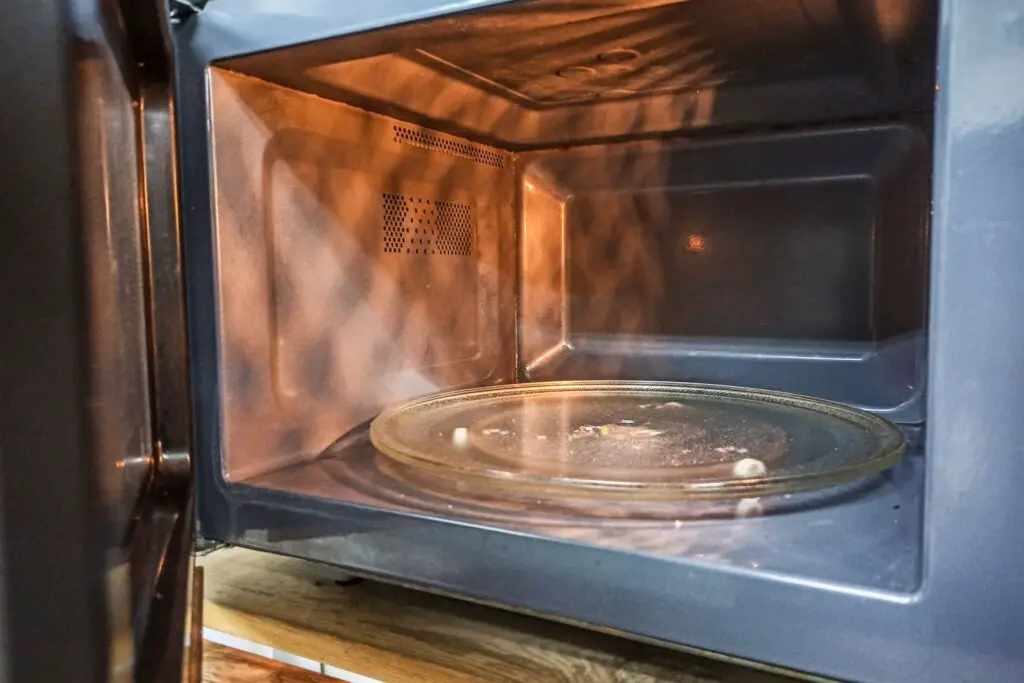Originally Created on: May 2, 2023 @ 9:20 am
How hot do microwaves get? It’s a good question and an important one to answer if you want to maximize the efficiency and safety of your kitchen appliance.
If you’re like most people, you’ve probably been using microwaves for years—like, since you were a teenager, at least. But when we think about microwaves, we often don’t consider the technology behind them.
The answer may surprise you: There is no definitive answer. However, there are some general guidelines that can help us better understand how microwaves work and why they can be so helpful in the kitchen.
In this article, I’ll share what I’ve learned about how hot the average microwave gets and what factors can affect its temperature.
Also Read: Where Does The Dirty Water Go In A Countertop Dishwasher? [The SURPRISING Truth]
Table of Content
How Hot Do Microwaves Get
The short answer is that the average microwave reaches a maximum temperature of 212 degrees Fahrenheit, which is the same as 100 degrees Celsius.
However, this temperature varies from microwave to microwave and depends on how powerful it is. For example, more powerful microwaves generally get hotter while weaker models may not reach such high temperatures.
When food is cooked in a microwave, it becomes hot due to the heat being generated by microwaves themselves. The microwaves produce electromagnetic waves that are absorbed by water molecules in food, causing them to vibrate and heat up rapidly.
As a result, the food can become very hot, sometimes reaching temperatures much higher than 212 degrees Fahrenheit depending on how long it is cooked for and how powerful your particular microwave is.
What Is the Highest Temperature a Microwave Can Reach?

Generally, microwaves produce heat ranging from 100 to 250 degrees Fahrenheit.
This is due to the fact that microwaves agitate the molecules in food, causing them to vibrate and generate heat, a process known as dielectric heating.
Microwaves heat food and beverages more quickly than conventional ovens because they use higher wattage settings, meaning the power output of a microwave is greater.
This means that when food is heated in a microwave, it tends to come out hotter and steamier than if it were heated using traditional methods.
As a result, you should always be careful when removing hot foods or liquids from the microwave.
Additionally, when cooking with a microwave, keep in mind that plastic wraps or containers should never be used because they can reach temperatures close to 250 degrees Fahrenheit and may cause melting or burning.
How To Gauge The Temperature Of Your Microwave
You might be wondering how you can tell how hot your microwave gets when it’s in use.
Interestingly, microwaves aren’t like conventional ovens, they don’t have a temperature gauge that you can look at to find out exactly how hot they get.
But don’t worry, there are a few ways to get an idea of what’s happening in your microwave:
Monitor Heating Time
This isn’t an exact science as food types, sizes, and temperatures vary. But if you notice that something takes longer than usual to heat, even at maximum power level—it could be because the microwaves getting lower than optimal temperatures.
Read Labels On Frozen Foods
Frozen foods usually come with instructions on how long they should be cooked in microwaves by looking at these instructions and then adjusting the cooking time appropriately for smaller or bigger portions, you can get a good idea about what temperature your microwave is reaching.
Finally, if you’re still curious as to what temperature your microwave gets up to, a good way to find out is by purchasing an infrared thermometer from your local hardware store and measuring the exterior surface temperature of your microwave while it’s running.
What Affects the Temperature in a Microwave?

You might be wondering what affects the temperature of a microwave. Well, there are several factors that can affect the temperature inside a microwave.
Wattage
The wattage of your microwave is one of the most important factors in controlling the temperature.
The higher the wattage, the hotter it will get. Generally speaking, microwaves range from 600 watts to 1,600 watts, so you can easily adjust how hot it gets based on what you’re cooking.
Temperature Settings
Most microwaves come with different heat settings that allow you to control how much power is being used, which in turn affects how hot it gets inside the microwave.
On low settings, microwaves use less power and therefore will generate lower temperatures than on high settings.
Type and Size of Dishes Used
The type and size of dishes used also play an important role in controlling temperatures. Metal dishes typically reflect microwaves and this can cause internal temperatures to spike if used for an extended time period.
Whereas larger dishes absorb more energy, which could lead to higher internal temperatures as well. So remember to always use appropriate cookware when using a microwave oven!
What Does Your Microwave Do When It Gets Too Hot

The good news about microwaves is that they are designed with thermal fuses and cutouts—things that can detect a rise in internal temperature and immediately shut down the microwave.
So if you find yourself wondering “How hot do microwaves get?” your answer is: not hot enough to create a fire hazard.
Your microwave will also stop working when it detects a fault in the diode, magnetron, or power levels; these components work together to ensure that everything runs smoothly and safely.
How Can You Prevent Your Microwave From Getting Too Hot?”
One of the most important things you can do to avoid your microwave getting too hot is to clean it often.
Every few weeks, take a damp cloth and wipe down the inside of the appliance – but be sure it’s unplugged! Grease and food particles accumulate on the walls and create a fire hazard if left too long.
Also, don’t forget about the fan vents around the outside. Clean any visible dust off so that air can circulate properly and not overheat your microwave.
Plus, make a habit of checking for torn door seals or worn insulation around the door. If either of these is damaged, it can cause overheating as well.
And finally, never run a microwave with no food in it as this will likely cause it to overheat and possibly even start a fire—so make sure you always have something cooking in there!
Conclusion
All in all, microwaves can generate quite a bit of heat, depending on their wattage, but the heat typically won’t come in direct contact with your food.
This means that you don’t have to worry about any part of your food being cooked to temperatures higher than it should be.
If you want to ensure that your food is cooked safely, make sure to use a food thermometer and check the internal temperature of your food. This is especially important when cooking meat, poultry, and other perishable food items.
The next time you’re wondering how hot your microwave is getting, you can rest assured that your meal is just as safe as it would be if it was cooked in the oven or on the stovetop.

![How Hot Do Microwaves Get [+ 3 AMAZING Tips]](https://mykitchenapex.com/wp-content/uploads/2023/05/How-Hot-Do-Microwaves-Get-3-AMAZING-Tips-1.jpg)